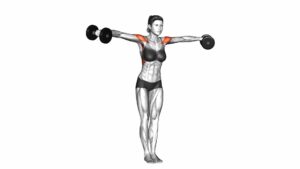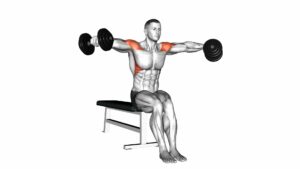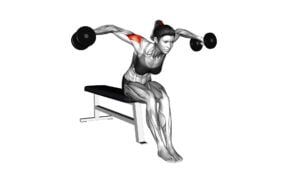Dumbbell Standing Bent Arm Lateral Raise (Male) – Video Exercise Guide & Tips

Looking to strengthen your shoulders and build upper body strength? The dumbbell standing bent arm lateral raise is the perfect exercise for you.
Watch This Exercise Video
In this video exercise guide, we'll show you the proper technique and offer helpful tips to maximize your results.
Avoid common mistakes and discover variations for more advanced training.
Get ready to incorporate this effective move into your workout routine and see the difference it can make.
Let's get started!
Key Takeaways
- The dumbbell standing bent arm lateral raise strengthens the shoulders and improves posture.
- It targets the deltoid muscles, specifically the middle and rear delts.
- This exercise increases shoulder stability and overall upper body strength.
- It engages muscles in the upper back and arms, improving shoulder mobility and correcting muscle imbalances.
Benefits of the Dumbbell Standing Bent Arm Lateral Raise
You can strengthen your shoulders and improve your posture with the dumbbell standing bent arm lateral raise exercise. This shoulder workout targets the deltoid muscles in your shoulders, specifically the middle and rear delts. By performing this exercise, you can increase shoulder stability and enhance your overall upper body strength.
The dumbbell standing bent arm lateral raise is a simple yet effective exercise that can be done with just a pair of dumbbells. To perform this exercise, start by standing with your feet shoulder-width apart and holding a dumbbell in each hand. Bend your arms at a 90-degree angle, with your palms facing your body. Keeping your back straight and core engaged, raise your arms out to the sides until they're parallel to the floor. Pause for a moment at the top of the movement, then slowly lower the dumbbells back to the starting position.
This exercise not only targets the shoulders but also engages the muscles in your upper back and arms. It helps to improve shoulder mobility and stability, which can be beneficial for athletes and individuals who perform activities that require overhead movements. Additionally, the dumbbell standing bent arm lateral raise can help correct muscle imbalances and improve overall posture, leading to better alignment and reduced risk of injury.
Incorporating the dumbbell standing bent arm lateral raise into your shoulder workout routine can help you achieve stronger, more defined shoulders while also improving your posture. Remember to start with lighter weights and gradually increase the resistance as you become more comfortable with the exercise.
Proper Equipment and Set-Up for the Exercise
To properly perform the Dumbbell Standing Bent Arm Lateral Raise, you'll need a pair of dumbbells of appropriate weight for your fitness level.
Start by standing with your feet shoulder-width apart and holding the dumbbells in your hands at your sides.
Make sure to keep your back straight and engage your core muscles for stability throughout the exercise.
Equipment Recommendations for Exercise
To properly perform the Dumbbell Standing Bent Arm Lateral Raise (Male), ensure you have the necessary equipment and set-up. Here are some equipment recommendations to help you get started:
- Dumbbells: Choose dumbbells that are an appropriate weight for your fitness level. Start with lighter weights and gradually increase as you get stronger.
- Exercise Mat: Use an exercise mat to provide cushioning and support for your knees and feet during the exercise.
- Mirror: Having a mirror in front of you can help you maintain proper form and technique throughout the exercise.
- Water Bottle: Stay hydrated during your workout by having a water bottle nearby. It's important to stay hydrated to perform at your best.
- Comfortable Clothing: Wear comfortable and breathable clothing that allows for full range of motion and prevents any restrictions during the exercise.
Correct Set-Up Techniques
After ensuring you have the necessary equipment and set-up, it's important to focus on proper techniques to perform the Dumbbell Standing Bent Arm Lateral Raise (Male) effectively.
To maintain proper form, stand with your feet shoulder-width apart and hold a dumbbell in each hand, palms facing your body. Keep your back straight and engage your core muscles.
Begin the movement by bending your elbows slightly, then raise your arms out to the sides until they're parallel to the floor. Hold this position for a brief moment, then slowly lower your arms back down to the starting position.
This exercise primarily targets the deltoid muscles in your shoulders, providing excellent muscle activation.
Now, let's move on to the step-by-step guide to performing the exercise.
Step-by-Step Guide to Performing the Exercise
To properly perform the dumbbell standing bent arm lateral raise, start by standing with your feet shoulder-width apart and a dumbbell in each hand. Keep your back straight and core engaged throughout the exercise.
Lift your arms out to the sides, bending your elbows slightly, until they're parallel to the floor. Avoid swinging your body or using momentum to lift the weights, and focus on using your shoulder muscles to raise and lower the dumbbells.
This exercise helps to strengthen and tone your shoulder muscles, improves posture, and enhances overall upper body strength.
Proper Form Demonstration
You can perform the dumbbell standing bent arm lateral raise exercise by following these step-by-step instructions:
- Stand with your feet shoulder-width apart and hold a dumbbell in each hand.
- Keep your back straight and engage your core muscles.
- Bend your elbows slightly and raise your arms out to the sides until they're parallel to the floor.
- Pause for a moment at the top of the movement, then slowly lower your arms back down to the starting position.
- Repeat for the desired number of repetitions.
By demonstrating proper form and using correct body alignment, you can maximize the effectiveness of this exercise and reduce the risk of injury.
Now, let's move on to the next section and discuss common mistakes to avoid.
Common Mistakes to Avoid
Now let's address some common mistakes to avoid when performing the dumbbell standing bent arm lateral raise exercise.
One mistake to watch out for is using too much weight. It's important to choose a weight that allows you to maintain proper form throughout the exercise.
Another mistake is swinging your body to generate momentum. This takes the focus away from the targeted muscles and can lead to injury. To maintain proper form, make sure to keep your back straight, your core engaged, and your elbows slightly bent throughout the movement.
Additionally, avoid lifting the dumbbells too high, as this can put unnecessary strain on your shoulders.
Benefits of This Exercise
When performing the dumbbell standing bent arm lateral raise exercise, one of the benefits is that it targets and strengthens the muscles of your shoulders and upper back. This exercise offers several benefits, including:
- Improved shoulder stability and mobility.
- Increased strength in the deltoids and trapezius muscles.
- Enhanced posture and upper body alignment.
- Engages the core for improved stability.
- Can be easily modified for different fitness levels and goals.
Variations and progressions of this exercise can be incorporated to further challenge and engage the targeted muscle groups. These include using heavier weights, performing the exercise on an incline bench, or incorporating a resistance band for added resistance.
Common Mistakes to Avoid During the Exercise
What are some key mistakes to avoid during the Dumbbell Standing Bent Arm Lateral Raise exercise? To ensure you get the most out of this exercise and prevent injuries, it's important to be mindful of proper technique and avoid muscle imbalances.
One common mistake is using improper form, such as swinging the weights or using momentum to lift them. This not only reduces the effectiveness of the exercise but also puts unnecessary strain on your joints. Instead, focus on controlled movements, lifting the weights with your shoulder muscles, and keeping your arms at a slight bend throughout the exercise.
Another mistake to avoid is using weights that are too heavy for your strength level. This can lead to improper form and increase the risk of injury. It's important to choose weights that allow you to perform the exercise with proper technique and without excessive strain.
Additionally, be mindful of any muscle imbalances you may have. If you notice that one side of your body is stronger or more dominant than the other, focus on maintaining balance by using the same weight and performing the same number of reps on each side.
Variations and Progressions for Advanced Training
Try incorporating these advanced variations and progressions into your Dumbbell Standing Bent Arm Lateral Raise exercise to take your training to the next level.
- Increase Weight: Gradually increase the weight of the dumbbells you're using to challenge your muscles and promote growth.
- One-Arm Lateral Raise: Perform the exercise with one arm at a time to further engage your shoulder muscles and improve stability.
- Seated Bent Arm Lateral Raise: Sit on a bench or chair while performing the exercise to isolate the shoulder muscles and reduce the involvement of other body parts.
- Resistance Band Lateral Raise: Use a resistance band instead of dumbbells to add variety and increase the tension throughout the movement.
- Arnold Press: Start with the dumbbells in a neutral grip position, then as you raise your arms, rotate the palms to face forward. This variation targets different parts of the shoulder muscles.
By incorporating these variations and progressions into your routine, you can challenge your muscles in new ways and continue to make progress.
Remember to always maintain proper form and start with lighter weights before progressing to more challenging variations. Keep pushing yourself and enjoy the rewards of your hard work!
Tips for Incorporating the Dumbbell Standing Bent Arm Lateral Raise Into Your Workout Routine
To incorporate the Dumbbell Standing Bent Arm Lateral Raise into your workout routine, continue building upon the advanced variations and progressions mentioned earlier.
Here are some tips for proper form and variations for beginners.
Firstly, it's important to maintain proper form throughout the exercise. Stand with your feet shoulder-width apart and hold a dumbbell in each hand, palms facing your body. Bend your elbows slightly and keep them fixed throughout the movement. Raise your arms out to the sides, keeping them parallel to the floor. Avoid swinging your body or using momentum to lift the weights. Focus on using your shoulder muscles to lift the dumbbells.
For beginners, it's recommended to start with lighter weights to develop proper technique and build strength gradually. You can also modify the exercise by performing it seated rather than standing. This can help stabilize your body and isolate the shoulder muscles more effectively.
As you progress, you can increase the weight and intensity of the exercise. You can also try variations such as performing the exercise on an incline bench, which targets different parts of the shoulder muscles.
Remember to always listen to your body and start with a weight that allows you to maintain proper form. Gradually increase the weight as you become more comfortable and confident with the exercise.
Frequently Asked Questions
How Much Weight Should I Use for the Dumbbell Standing Bent Arm Lateral Raise?
To properly perform the dumbbell standing bent arm lateral raise, it's important to determine the appropriate weight for your workout. The amount of weight you should use depends on your fitness level and strength. Start with a weight that challenges you but allows you to maintain proper form throughout the exercise.
Gradually increase the weight as you get stronger. Incorporating this exercise into your shoulder workout routine can help improve shoulder strength and stability.
Can I Perform This Exercise if I Have Shoulder or Elbow Pain?
If you're experiencing shoulder or elbow pain, it's important to prioritize pain management and avoid exercises that aggravate your condition. The dumbbell standing bent arm lateral raise may not be suitable for you at the moment.
Instead, focus on exercises that target the same muscle groups but with less strain on your joints.
Consult with a healthcare professional or a certified trainer for modifications that can help you work around your pain while still achieving your fitness goals.
How Many Sets and Repetitions Should I Do for This Exercise?
To progress and increase difficulty for the dumbbell standing bent arm lateral raise, you can gradually increase the weight of the dumbbells. Start with a weight that you can comfortably lift for 8-12 repetitions and aim to do 2-3 sets.
As you get stronger, you can increase the number of sets or repetitions. Be sure to avoid common mistakes like using momentum to lift the weights or shrugging your shoulders. Focus on maintaining proper form throughout the exercise.
Are There Any Alternative Exercises That Target the Same Muscles as the Dumbbell Standing Bent Arm Lateral Raise?
If you're looking for alternative exercises that target the same muscles as the dumbbell standing bent arm lateral raise, there are a few options you can try.
One exercise is the cable lateral raise, which can provide a similar shoulder workout.
Another option is the seated dumbbell lateral raise, which also targets the same muscles.
Additionally, you can do the seated cable lateral raise or the machine lateral raise to work those shoulder muscles effectively.
Can I Do This Exercise Without Dumbbells and Still Get Similar Benefits?
Without dumbbells, you can still get similar benefits to the dumbbell standing bent arm lateral raise. Bodyweight exercises offer their own advantages, such as improved stability and control.
To modify the exercise, you can perform standing lateral raises without weights by using your own body as resistance. Keep your arms bent and raise them out to the sides, engaging your shoulder muscles.
This modification can help you achieve similar results without the need for dumbbells.
Conclusion
The dumbbell standing bent arm lateral raise is a great exercise for targeting the shoulder muscles. It helps improve shoulder strength, stability, and posture.
Proper equipment and set-up are crucial for performing this exercise correctly. By following the step-by-step guide and avoiding common mistakes, you can maximize the benefits and avoid injury.
For advanced training, there are variations and progressions available. Incorporating this exercise into your workout routine will help you achieve stronger and more defined shoulders.

Author
Years ago, the spark of my life’s passion ignited in my mind the moment I stepped into the local gym for the first time. The inaugural bead of perspiration, the initial endeavor, the very first surge of endorphins, and a sense of pride that washed over me post-workout marked the beginning of my deep-seated interest in strength sports, fitness, and sports nutrition. This very curiosity blossomed rapidly into a profound fascination, propelling me to earn a Master’s degree in Physical Education from the Academy of Physical Education in Krakow, followed by a Sports Manager diploma from the Jagiellonian University. My journey of growth led me to gain more specialized qualifications, such as being a certified personal trainer with a focus on sports dietetics, a lifeguard, and an instructor for wellness and corrective gymnastics. Theoretical knowledge paired seamlessly with practical experience, reinforcing my belief that the transformation of individuals under my guidance was also a reflection of my personal growth. This belief holds true even today. Each day, I strive to push the boundaries and explore new realms. These realms gently elevate me to greater heights. The unique combination of passion for my field and the continuous quest for growth fuels my drive to break new ground.







